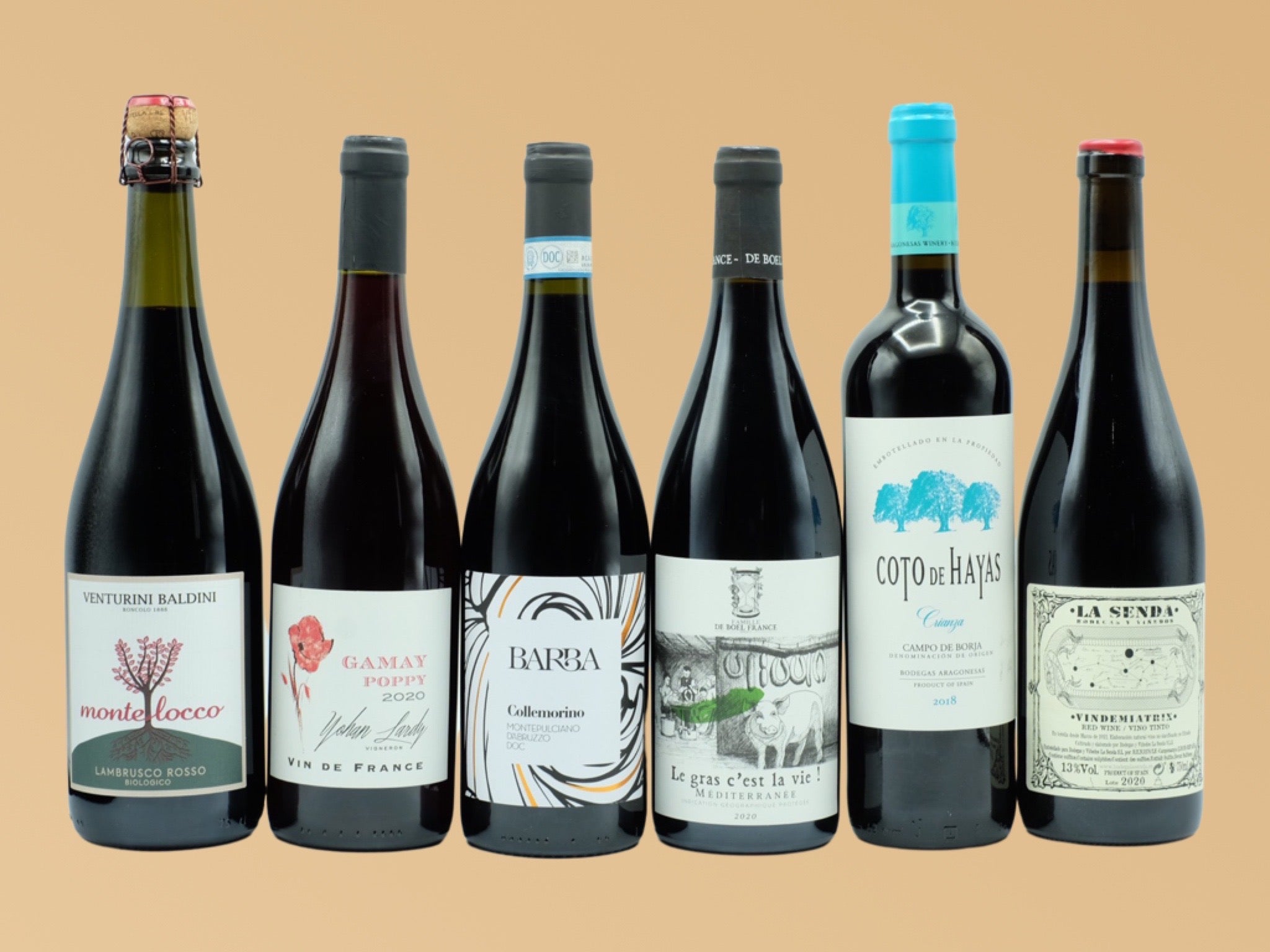| Hello wine clubbers, we're pleased to introduce the March edition of Vine Arts Wine Club! This month we have an all European lineup for you - including two Italian wines, two French wines, and two Spanish wines. We hope you enjoy them! If you do have any questions or would like any additional details about these wines, please let us know. For subscribers who pick up their wines, your bags will be ready for pickup on Tuesday, March 1st. For subscribers who have signed up for delivery, your bags will be sent out on Thursday, March 3rd. |
| NV Venturini Baldini Montelocco Lambrusco Emilia-Romagna, Italy $28.40 | Where The Venturini Baldini wine estate is located between Parma and Reggio Emilia in the heart of the Lambrusco Emilia IGP appellation of Emilia-Romagna. Positioned on the northeastern side of the Apennine mountain range, Emilia-Romagna is one of the wealthiest regions in Italy. With a highly developed local economy (Ferrari, Maserati and Lamborghini are based here) and an impressive food culture, the standard of living in Emilia-Romagna is the highest in the country. The region spans the width of the Italian peninsula and is home to over 58,000 hectares of vineyards which are planted on the plains and on the foothills of Apennines. What Lambrusco is Emilia-Romagna’s most famous wine. This red sparkling wine, which can trace its origins back to the time of the Romans, became hugely popular in the 1980’s. Unfortunately the style that was exported in the 80’s was mostly of low quality. Much like with German Riesling, Lambrusco is still regaining its reputation outside of Italy. In contrast, within Italy Lambrusco has always enjoyed a strong reputation. The Montelocco Lambrusco is made from 100% Lambrusco Salamino, one of the main Lambrusco varieties. The name “Lambrusco” is actually applied to a family of similar but distinct grape varieties. Salamino gets its name from the shape of the grape clusters, which resemble a salami. Made from organically farmed grapes, the wine gets its effervescence from a secondary fermentation in a sealed tank (charmat/martinotti method). This is the same approach used for Prosecco. A dosage of 16 g/l of residual sugar balances the wine's pronounced acidity. Who Founded in 1976, the Venturini Baldini estate encompasses 130 hectares of land. The winery was purchased in 2013 by Giuseppe and Julia Prestia, who took over the estate from the Venturini Baldini family. To elevate the quality of the wines, the couple brought on consultant winemaker Carlo Ferrini, whose previous work with Sicily’s Donnafugata has brought Carlo international notoriety. Farmed organically since the 1990’s, the estate’s 30 hectares of vines are sited between 170 and 370 meters in elevation. In the vineyard everything is done manually and yields are exceptionally low for the region. Taste If you haven’t tried Lambrusco before, this wine may come as a surprise. Although red, it’s served chilled like white wine. Deep purple in the glass with frothy pink foam, on the nose it has lush aromas of raspberry, blackberry, pomegranate, and balsamic. The palate is flavourful with black fruit flavors, fresh tannins and tart acidity. The finish is fruity and dry to the taste. When deciding what to pair with this wine you have a wealth of options to choose from. Absolutely brilliant with Ravioli Bolognese, it’s a revelation with Prosciutto di Parma. |
| 2020 Yohan Lardy Poppy Gamay Beaujolais, France $22.07 | Where Beaujolais is a wine appellation located northwest of the city of Lyon in central France. Fifty five kilometers long and fourteen kilometers wide, it’s bordered to the north by the vineyards of Burgundy and to the east by the Saône River. To the west lie the highlands of the Massif Central, which help moderate Beaujolais’ continental climate. Topographically the region is broken into two separate areas. The north consists of rolling granitic hills, while the south is flatter with richer clay/sandstone soils. What Light and fresh, Beaujolais is the preferred wine of the traditional Lyonnais brasserie. It’s made from 100% Gamay, a thin-skinned grape variety that’s experiencing a resurgence with wine lovers. A known cross of Pinot Noir and Gouais, Gamay is friendlier to cultivate than it’s ‘noble’ Burgundian parent. Popular with the everyday people of central France during the middle-ages, Gamay was actually expelled from Burgundy during the 1300’s by Philippe the Bold. Unappreciated by the Duke of Burgundy, it was in Beaujolais that Gamay flourished. Today Beaujolais’ wine industry is dominated by negociants who produce 90% of the region's wines. Countering the negociants' predominance are a small group of producers who farm their own vines and estate bottle the wines. It’s small winemakers like Yohan Lardy that are reshaping the image of Beaujolais. The Poppy Gamay is made from grapes sourced from 60 year old Beaujolais-Villages vines, plus some fruit from Moulin-a-Vent. The wine is named after the poppy flowers that grow in his vineyards. Hand-harvested, the grapes were naturally whole-cluster fermented with partial carbonic maceration for 7 days. Aged for 4 months in concrete tanks, the wine was neither fined or filtered. Who Yohan Lardy is a young, forward thinking winemaker based in the village of Moulin-a-Vent. Following in the footsteps of his father Lucien, Yohan is part of Terroirs Originels, a collection of 25 growers who share the same passion to produce authentic wines. His 2 hectares of vines, the oldest of which were planted in 1911 to pink granite soils, are located in the prestigious "Les Michelons" parcel. Farming his vines sustainably to promote biodiversity in the vineyard, his wines are produced with natural yeasts and without additional sulphites. In Yohan’s words - “Every day in my vineyards, I work with and in respect of nature in order to express my terroir the most naturally and purely possible”. Taste The Poppy Gamay is a classic example of refreshing French “vin de soif” “(wine for thirst”). Pale ruby red in colour, on the nose it shows youthful aromas of strawberries, cranberries, violet petals, and wet earth. The palate is light bodied with delicate tannins, thirst-quenching acidity and plummy red fruit flavours. Elegant and friendly, this is what good Beaujolais should be. Drink it on its own or with old-school vegetable driven dishes like ratatouille. |
| 2020 Barba Colle Morino Montepulciano d’Abruzzo Abruzzo, Italy $21.60 | Where Located to the east of Rome on the Adriatic coast, Abruzzo is one of the most untamed regions in Italy. Scantily populated, around one third of Abruzzo is registered as national park space. Almost three quarters of the terrain is tough and mountainous. The peaks here rise to almost 3,000 meters in elevation! Isolated by harsh topography, wine-making in the region evolved in relative seclusion. Vineyards planted on river valley hillsides benefit from the moderating effects of the Adriatic. These river valleys begin in the mountains and flow east to where they empty into the sea. What The main DOC for red wine production in Abruzzo is Montepulciano d'Abruzzo. This designation is not to be confused with Vino Nobile di Montepulciano, which is a designation for wines made around the Tuscan village of Montepulciano. In the case of Montepulciano d'Abruzzo we are talking about Montepulciano “the grape”, and not Montepulciano “the place”. Confusing, you bet. Under Italian wine law, wines labeled as Montepulciano d'Abruzzo must contain at least 85% Montepulciano with up to 15% of Sangiovese to round things out. It must also be aged for at least 5 months prior to release. The Colle Morino Montepulciano d’Abruzzo is made from grapes harvested from the Colle Morino, Passo Madama and Colle della Corte vineyards in Pineto. Spreading 35 hectares, the average age of the vines is 15 years. Fermented in stainless steel tanks, the wine was macerated on the skins for 15 days. This was followed by malolactic fermentation and aging in steel for 60 days. Who The history of the Barba family can be traced back to Naples in the 15th century. At this time a descendent of the family, one Francesco Barba, held office as an abbot with the Holy Roman Church. Over time the family migrated north to Abruzzo, settling in the province of Teramo. It was during the 18th century that the family started to accumulate land. Two centuries later Luigi Barba decided to convert the family's holdings from sharecropping to a modern wine estate. Today the business is run by Giovanni Barba, who looks after all the day to day operations of the family's 27.5 hectares of vineyards. In addition to vines, the family also tend olive groves, fruit orchards, timber plants and raise Friesian Dutch cows. Taste Bursting with fruity flavors, this Montepulciano is a wine that aims to please. Medium ruby in the glass, the nose has juicy aromas of sour cherries, plum jam, oregano, licorice and tobacco. Generous in body, the palate is dominated by robust blackfruits, firm tannins, and tart acidity. The finish is fruity and dry. A perfect pairing option for pizza, a traditional match for this wine is arrosticini (grilled lamb skewers). |
| 2020 Famille De Boel ‘Le gras c’est la vie!’ Rouge Méditerranée IGP, France $22.63 | Where The Méditérranée IGP is a large wine appellation that covers much of southeastern Mediterranean France. It’s so big that it’s difficult to give a single overarching description of the region. Within its borders are the areas of Provence, Isère, Loire, part of the Rhône Valley, and even sections of the island of Corsica. Strewn with a motley collection of terroirs, the overall climate of the IGP is, unsurprisingly, Mediterranean in nature. Most of the vineyards are sited in the hills and valleys of the Alpine foothills, where vines receive ample sunshine and experience strong diurnal temperature swings. The sturdy Mistral descends from the north, buffeting the area with sometimes hurricane strength winds. What Like other IGP’s, the Méditerranée IGP is most often used by winemakers who are looking for less stringent rules. Accepting lesser known grape varieties, it's a way for winemakers to experiment while still including a geographical indicator on the label. ‘Le gras c’est la vie!’ is the kind of wine we could drink everyday. The kind of wine that refreshes while you indulge in mounds of stinky cheese and salty charcuterie. It’s no coincidence that the name of this wine means “fat is life!”. Made from 45% Caladoc, 40% Grenache, and 15% Carignan, the grapes were harvested from young biodynamic farmed vines planted in the Southern Rhône. Who An exciting new producer at Vine Arts! Famille de Boel France is a small family estate owned by Nelly France and Arnaud De Boel. Nelly, who is originally from Brittany, met Arnaud (who is Belgian) when they were working in New Zealand in 2009. Interested in biodynamic farming and winemaking, the couple decided to purchase vineyards in the Northern Rhône. In addition to holdings in Cornas and Saint Joseph, the couple also own some land in the Southern Rhône close to the villages of Suze-la-Rousse and Sainte-Cécile-les-Vignes. Together Nelly and Arnaud craft honest and food-friendly wines meant to be shared with family and friends Taste Bright and brambly, this medium bodied wine has fine tannins, medium acidity, and juicy red fruit flavours. Medium ruby in colour, notes of red currants, bing cherry, and licorice are complemented by a dash of meaty spice. The finish is dry and refreshing. The perfect match for rustic French saucisson! |
| 2018 Bodegas Aragonesas Coto de Hayas Crianza Campo de Borja, Spain $23.91 | Where Campo de Borja is a hot and arid wine region located in northern Spain. Situated southeast of Rioja and Navarra on the south bank of the Ebro river, the appellation was officially recognized with a DO in 1980. First planted to vine during the time of the Romans, today there are around 6,300 hectares of vineyards. In an area this hot, elevation is a major factor for grape growers. Most of Campo de Borja's vineyards are located between 450–550 meters, where warm days are juxtaposed by cool nights. Rainfall is scant, with only 350mm of precipitation annually in low-lying areas. What Like in neighboring Navarra, the dominant grape in Campo de Borja is Garnacha. The variety is so dominant that the region is known as “El Imperio de la Garnacha” (the Empire of Garnacha). Other commonly planted varieties include Tempranillo, Cabernet Sauvignon, Merlot, Mazuelo (Carinena) and Syrah. Due to the arid conditions, yields are exceptionally low but concentrated. Campo de Borja Garnacha is renowned for its intensity and power. The Bodegas Aragonesas Coto de Hayas Crianza is made from a blend of Garnacha and Tempranillo harvested from vines ranging in age from 30 to 40 years. Vinified in a stainless steel tank with 15 days of skin maceration, the wine was aged in a combination of French and American barrels for 6-9 months. Who Founded in 1984 in Fuendejalón, Bodegas Aragonesas is one of the key wineries in Campo de Borja. It was formed when two cooperatives in Fuendejalón and Magallón joined forces. Under the guidance of Javier Vela, the winery produces a range of brands - Fagus, Coto de Hayas, Garnacha Centenaria, Galiano, Don Ramón and Aragonia. Planted to an array of grape varieties and extending 3,700 hectares, the estate’s oldest vines are over 100 years old. Taste Fans of ripe and succulent red wines will really enjoy the Coto de Hayas Crianza. Vibrant ruby in colour, the nose has sweet aromas of black cherry compote, blackberry pie filling, cinnamon and nutmeg. Medium bodied, the palate is lush with mouth filling blackfruit flavours and silky tannins. The wine's lush character extends to a juicy and dry finish. A great sweet and savoury pairing for pork tonkatsu. |
| 2020 Bodegas La Senda Vindemiatrix Bierzo, Spain $30.40 | Where The region of Bierzo is located in the northwest corner of Spain in Castilla y Leon. Officially granted DO (denominación de origen) status in 1989, the area benefits from a unique microclimate. To the west, the Atlantic brings an average rainfall of around 28 inches and moderate temperatures. To the east, inland Castile brings warmth and drier conditions. The average temperature is a cool 12°C, with lows of 3.5°C and highs of 24°C. The region is further divided into the two separate subregions of Alto Bierzo (hilly and mountainous) and Bajo Bierzo (flat plains). Both areas benefit from the nearby Cordillera Cantábrica mountain range, which shelters the region's vineyards from harsh weather. What The Vindemiatrix is made mostly from Bierzo’s preferred red grape variety, Mencia, with smaller percentages of Palomino and Doña Blanca included. Violet-blue in colour with thick skins, Mencia was once relegated to simple table wines. With the discovery of well-sited old vines by Spanish winemakers in the 1990’s, Mencia’s reputation has skyrocketed. Today it is often compared to floral Pinot Noir or herbaceous Cabernet Franc. As a variety, Mencia is high in terpenoids, a compound that brings floral aromas of strawberry, raspberry, and pomegranate. The grape variety Palomino, the main grape variety used in Sherry, is generally more known for its neutral character. Doña Blanca is a more obscure grape variety grown in northern Portugal and Galicia. Low in acidity, it’s typically blended with Godello. The grapes for the Vindemiatrix were harvested from seven parcels of old vines that range in age between 60-90 years. Like most old parcels, the vines are interplanted to red and white grape varieties. Harvested together, the different grape varieties were co-fermented using indegenous yeasts. Both fermentation and elevage took place in unlined concrete tanks for 7 months. Who Bierzo tends to attract certain types of winemakers. They’re people less drawn to the conventions of Spain's well established wine regions; people in search of authenticity. Diego Losada is such a winemaker. Trained in organic chemistry, Diego spent his early years working for various large wineries. Conventional mass production winemaking did not suit his mindset. In response he decided to purchase 5 hectares of vineyards in Bierzo, and created Bodegas La Senda. Spread across 15 parcels, the vines are farmed according to biodynamic principles without the aid of chemicals. Tended entirely by hand, the old vines (the youngest vines are 50 years old!) are planted to a mixture of Mencía, Doña Blanca, Palomino, Garnacha, Godello, and Malvasia. The yields he gets from these vines are up to 6 times lower than conventionally farmed vines in the region, giving Diego exceptionally concentrated and complex fruit. Taste The gateway to Diego’s wines, the Vindemiatrix showcases the wild character of Mencia and Bierzo. Medium ruby in colour, on the nose there are smoky aromas of wild black currants, sour cherries, crushed stone, and hickory. The palate is medium bodied with earthy red fruit flavors, fine grained tannins and tart acidity. The finish is piquant and dry. When it comes to pairing this wine with food, look to the hearty traditional stews of northern Spain like alubias de cantabria, which is both healthy and very filling. |


